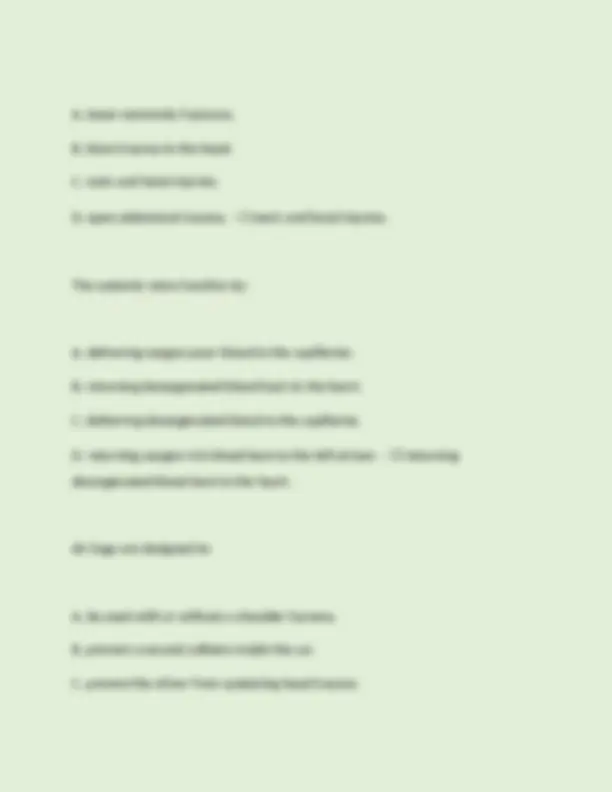













Study with the several resources on Docsity

Earn points by helping other students or get them with a premium plan


Prepare for your exams
Study with the several resources on Docsity

Earn points to download
Earn points by helping other students or get them with a premium plan
Community
Ask the community for help and clear up your study doubts
Discover the best universities in your country according to Docsity users
Free resources
Download our free guides on studying techniques, anxiety management strategies, and thesis advice from Docsity tutors
A valuable resource for emt students preparing for block 6 exams. it features a series of multiple-choice questions covering various aspects of emergency medical care, including trauma, physiology, and patient assessment. the inclusion of answers allows for self-assessment and knowledge reinforcement, enhancing learning and exam preparation. the questions are designed to test understanding of key concepts and clinical scenarios.
Typology: Exams
1 / 19

This page cannot be seen from the preview
Don't miss anything!












The lower jaw bone is called the: A. zygoma. B. maxilla. C. mandible. D. mastoid. - ✅✅mandible. The act of pulling on a body structure in the direction of its normal alignment is called: - ✅✅Traction During the normal wound healing process, bleeding may occur from even a minor injury because: A. there is a substantial decrease in the number of platelets in and around the wound, which increases the risk of bleeding. B. histamines released by the immune system constrict the blood vessels, which increases the pressure within them. C. new capillaries that stem from intact capillaries are delicate and take time to become as stable as the preexisting capillaries. D. bacteria and other microorganisms invade the wound site and damage the capillaries, which makes them more prone to bleeding. - ✅✅New capillaries that
stem from intact capillaries are delicate and take time to become as stable as the preexisting capillaries. Pleural fluid is contained between the: A. visceral and parietal pleurae. B. parietal pleura and the heart. C. visceral pleura and the lung. D. parietal pleura and the chest wall. - ✅✅visceral and parietal pleurae. A 70-year-old man presents with a severe nosebleed. His medical history includes COPD, depression, and a hemorrhagic stroke 3 years ago. His BP is 190/110 mm Hg, his pulse is 100 beats/min, and his respirations are 24 breaths/min. His medications include albuterol, sertraline (Zoloft), and multivitamins. Which of the following is MOST likely causing his nosebleed today? Select one: A. Diabetic complications B. Hemorrhagic stroke C. High blood pressure D. His prescribed albuterol - ✅✅High blood pressure
ground. He is holding his left arm in a fixed position away from his body. There is an obvious anterior bulge to the area of injury. You should: A. assess distal pulse, motor, and sensory functions. B. gently attempt to move his arm toward his body. C. place a pillow under his arm and apply a swathe. D. flex his arm at the elbow and then apply a sling. - ✅✅assess distal pulse, motor, and sensory functions The presence of tachycardia following a significant abdominal injury: A. is always accompanied by hypotension. B. indicates a state of decompensated shock. C. should be assumed to be a sign of shock. D. is most commonly caused by severe pain. - ✅✅should be assumed to be a sign of shock. In order for sweating to be an effective cooling mechanism: A. several layers of clothing must be worn.
B. it must be able to evaporate from the body. C. the relative humidity must be above 90%. D. the body must produce at least 1 L per hour. - ✅✅it must be able to evaporate from the body. A 37-year-old male was pinned between a flatbed truck and a loading dock. On exam, you find bruising to the chest, distended neck veins, bilaterally diminished breath sounds, and bilateral scleral hemorrhaging. You should: A. suspect a severe hemopneumothorax. B. request a paramedic ambulance. C. perform a secondary assessment. D. aggressively manage his airway. - ✅✅aggressively manage his airway. An epidural hematoma is MOST accurately defined as: A. bleeding between the skull and dura mater. B. bleeding between the dura mater and brain. C. venous lacerations that occur within the brain.
A. below the anterior superior iliac spines of the pelvis and against the hip joints. B. across the abdominal wall at the level of the umbilicus and against the hip joints. C. across the abdominal wall at the level of the diaphragm and below the hip joints. D. above the anterior posterior iliac spines of the pelvis and below the hip joints. - ✅✅below the anterior superior iliac spines of the pelvis and against the hip joints. By what mechanism is a person injured when he or she falls from a significant height? A. As the person falls, the amount of kinetic energy is converted into work; work is then converted to kinetic energy upon impact. B. Kinetic energy is converted to potential energy; the potential energy is then converted into the work of bringing the body to a stop. C. Potential energy is created as the person is falling; the potential energy is then converted into kinetic energy upon impact. D. Potential energy is converted to kinetic energy; the kinetic energy is then converted into the work of bringing the body to a stop. - ✅✅D. Potential energy is converted to kinetic energy; the kinetic energy is then converted into the work of bringing the body to a stop.
Which of the following statements regarding striated muscle is correct? A. Striated muscle is involuntary because you have no conscious control over it. B. Most of the body's striated muscle is found within the walls of the blood vessels. C. Striated muscle tissue is attached directly to the bones by tough bands of cartilage. D. It forms the major muscle mass of the body and usually crosses at least one joint. - ✅✅It forms the major muscle mass of the body and usually crosses at least one joint. Which of the following conditions would be the LEAST likely to increase a person's risk of hypothermia? A. hypoperfusion B. severe infection C. hyperglycemia D. spinal cord injury - ✅✅hyperglycemia
A. lower-extremity fractures. B. blunt trauma to the head. C. neck and facial injuries. D. open abdominal trauma. - ✅✅neck and facial injuries. The systemic veins function by: A. delivering oxygen-poor blood to the capillaries. B. returning deoxygenated blood back to the heart. C. delivering deoxygenated blood to the capillaries. D. returning oxygen-rich blood back to the left atrium. - ✅✅returning deoxygenated blood back to the heart. Air bags are designed to: A. be used with or without a shoulder harness. B. prevent a second collision inside the car. C. prevent the driver from sustaining head trauma.
D. decrease the severity of deceleration injuries. - ✅✅decrease the severity of deceleration injuries. The ________ nerves control the diaphragm. A. vagus B. costal C. phrenic D. intercostal - ✅✅phrenic An organ or tissue may be better able to resist damage from hypoperfusion if the: A. body's demand for oxygen is markedly increased. B. body's temperature is considerably less than 98.6°F (37.0°C). C. systolic arterial blood pressure is at least 60 mm Hg. D. heart rate is maintained at more than 100 beats/min. - ✅✅body's temperature is considerably less than 98.6°F (37.0°C). The phrenic nerves control the diaphragm and exit the spinal cord at:
B. sclera. C. pupil. D. cornea. - ✅✅retina Heat loss from the body through respiration occurs when: A. warm air is exhaled into the atmosphere B. the core body temperature is greater than 98F (37C) C. cool air is inhaled and displaces warm air D. air temperature is greater than body temperature - ✅✅warm air is exhaled into the atmosphere Rapid deceleration of the head, such as when it impacts the windshield, causes: A. compression injuries and contusions to the anterior, posterior, and lateral aspects of the brain. B. primary impact to the posterior aspect of the brain, resulting in compression injuries, bruising, or torn blood vessels. C. stretching or tearing of the anterior aspect of the brain and compression injuries or bruising to the posterior aspect of the brain.
D. compression injuries or bruising to the anterior portion of the brain and stretching or tearing to the posterior portion of the brain. - ✅✅compression injuries or bruising to the anterior portion of the brain and stretching or tearing to the posterior portion of the brain. The cervical spine is MOST protected from whiplash-type injuries when the: A. airbag correctly deploys upon impact B. pt. tenses up a the time of impact C. rear end of the vehicle is intially struck D. headrest is appropriately positioned. - ✅✅headrest is appropriately positioned. A partial-thickness burn involves the outer layer of skin and a portion of the: A. epidermis. B. fatty layer. C. muscle fascia. D. dermal layer. - ✅✅dermal layer.
C. gray mater. D. dura mater. - ✅✅dura mater What layer of the skin forms a watertight, protective seal for the body? A. dermis B. epidermis C. muscular layer D. subcutaneous layer - ✅✅epidermis Assuming that no obvious signs of intra-abdominal injury are present, which of the following injuries would MOST likely cause an injury to the liver or spleen to be overlooked? A. Femur fracture B. Pelvic fracture C. Lumbar spine fracture D. Shoulder fracture - ✅✅Lumbar spine fracture
Bleeding within the brain tissue itself is called a(n): A. epidural hematoma B. intracerebral hematoma C. subdural hematoma D. intracranial hematoma - ✅✅intracerebral hematoma Early signs and symptoms of intra-abdominal bleeding include: A. bruising only. B. pain and distention. C. widespread ecchymosis. D. significant hypotension. - ✅✅pain and distention. Bruising to the right upper quadrant of the abdomen following blunt trauma is MOST suggestive of injury to the: A. liver. B. spleen.
A. lungs B. trachea C. vena cavae D. esophagus - ✅✅lungs A 39-year-old male sustained a large laceration to his leg during an accident with a chainsaw and is experiencing signs and symptoms of shock. You should: A. apply direct pressure to the wound. B. place the patient on 100% oxygen. C. follow appropriate standard precautions. D. perform a rapid head-to-toe assessment. - ✅✅follow appropriate standard precautions. Bone marrow produces: A. platelets. B. blood cells. C. lymphocytes. D. electrolytes. - ✅✅blood cells.